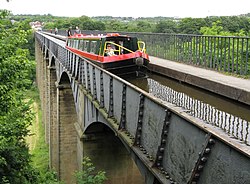
Back Pontcysyllte Wætertyge ANG قناة بونكتيسيلت Arabic Акведук Понткісілтэ Byelorussian Aqüeducte de Pontcysyllte Catalan Pontcysylltský akvadukt Czech Dyfrbont Pontcysyllte Welsh Pontcysyllte Akvædukt Danish Pontcysyllte-Aquädukt German Akvedukto Pontcysyllte Esperanto Acueducto de Pontcysyllte Spanish
Pontcysyllte Aqueduct Traphont Ddŵr Pontcysyllte | |
|---|---|
 | |
| Coordinates | 52°58′14″N 03°05′16″W / 52.97056°N 3.08778°W |
| OS grid reference | SJ270420 |
| Carries | Llangollen Canal |
| Crosses | River Dee |
| Locale | Froncysyllte, Wrexham, Wales |
| Maintained by | Glandŵr Cymru – the Canal & River Trust |
| Heritage status | Grade I listed |
| Characteristics | |
| Trough construction | Cast iron |
| Pier construction | Stone |
| Total length | 336 yd (307 m) |
| Width | 12 ft (3.7 m) |
| Height | 126 ft (38 m) |
| Water depth | 5 ft 3 in (1.60 m) |
| Traversable? | Yes |
| Towpaths | East side |
| No. of spans | 18 |
| Piers in water | 4 |
| History | |
| Designer | Thomas Telford |
| Construction start | 25 July 1795 |
| Opened | 26 November 1805 |
| Official name | Pontcysyllte Aqueduct and Canal |
| Criteria | Cultural: i, ii, iv |
| Reference | 1303 |
| Inscription | 2009 (33rd Session) |
| Area | 105 ha |
| Buffer zone | 4,145 ha |
| Location | |
 | |
The Pontcysyllte Aqueduct (Welsh pronunciation: [ˌpɔntkəˈsəɬtɛ]; Welsh: Traphont Ddŵr Pontcysyllte) is a navigable aqueduct that carries the Llangollen Canal across the River Dee in the Vale of Llangollen in northeast Wales.
The 18-arched stone and cast iron structure is for use by narrowboats and was completed in 1805 having taken ten years to design and build. It is 12 feet (3.7 metres) wide and is the longest aqueduct in Great Britain as well as the highest canal aqueduct in the world. A towpath runs alongside the watercourse on one side.[1][2]
The aqueduct was to have been a key part of the central section of the proposed Ellesmere Canal, an industrial waterway that would have created a commercial link between the River Severn at Shrewsbury and the Port of Liverpool on the River Mersey. Although a less expensive construction course was surveyed further to the east, the westerly high-ground route across the Vale of Llangollen was preferred because it would have taken the canal through the mineral-rich coalfields of North East Wales. Only parts of the canal route were completed because the expected revenues required to complete the entire project were never generated. Most major work ceased after the completion of the Pontcysyllte Aqueduct in 1805.
The structure is a Grade I listed building[3] and part of a UNESCO World Heritage Site.
- ^ "Aqueduct crowned world 'wonder'". BBC News. 27 June 2009.
- ^ Clover, Charles (11 January 2008). "Pontcysyllte Aqueduct in World Heritage bid". Daily Telegraph.
- ^ "Listed Buildings: Pontcysyllte Aqueduct, Trevor". Wrexham.gov.uk. Archived from the original on 13 October 2008. Retrieved 25 May 2007.